The interior of black holes has long puzzled scientists, with its enigmatic properties challenging our understanding of the universe. In 1916, physicist Karl Schwarzschild proposed a solution to Albert Einstein’s general relativity equations, which described black holes as having a singularity at their center. This singularity represents a point where the laws of physics, including Einstein’s theory of relativity, break down, and the concept of causality becomes meaningless. Unsurprisingly, this presented a significant obstacle for scientific exploration, as it implied that black holes were information voids, with no data able to escape their event horizon. However, recent discoveries, such as the first image of a black hole captured by the Event Horizon Telescope in 2019, have reignited interest in Schwarzschild’s solution.
In 2001, physicists Pawel Mazur and Emil Mottola proposed an alternative solution to Einstein’s equations, introducing the concept of gravitational condensate stars or gravastars. These objects, unlike black holes, offer several advantages from a theoretical astrophysics standpoint. While they share a comparable compactness to black holes and possess a surface gravity of similar strength, gravastars do not feature an event horizon nor a singularity at their core. Instead, the center of a gravastar is composed of dark energy, which counters the immense gravitational force, preventing a singularity from forming. Furthermore, a wafer-thin layer of ordinary matter forms the gravastar’s surface, infinitely close to zero thickness.
Enter the Nestar: A Matryoshka Doll of Gravastars
Building upon Mazur and Mottola’s work, theoretical physicists Daniel Jampolski and Prof. Luciano Rezzolla from Goethe University Frankfurt have recently unveiled a groundbreaking addition to the realm of gravastars – the nestar. Like a set of nested matryoshka dolls, the nestar represents a gravastar within another gravastar. Jampolski’s discovery of this hypothetical celestial object emerged from his Bachelor’s thesis under the guidance of Luciano Rezzolla. In their publication in Classical and Quantum Gravity, Jampolski and Rezzolla describe the intricate nature of the nestar and its multiple layers.
While Mazur and Mottola’s gravastars possess an almost infinitely thin shell, the nestar’s configuration introduces a novel feature – a slightly thicker matter-composed shell. This distinction makes it somewhat easier to visualize the existence of such an object. However, despite this advancement in our conceptualization, the creation mechanism for a gravastar, including the nestar, remains a profound mystery.
Luciano Rezzolla, a Professor of Theoretical Astrophysics at Goethe University, highlights the importance of continuing to find new solutions to Einstein’s field equations even a century after Schwarzschild’s pioneering work. Discovering such solutions is comparable to stumbling upon a rare treasure, illuminating uncharted territory within our understanding of the universe. The enigmatic nature of gravastars and the recent addition of the nestar exemplify the continued growth and evolution of astrophysics, challenging previous conceptions and pushing the boundaries of scientific exploration.
The exploration of black holes and their interior remains one of the most captivating areas of scientific research. While the singularity at the heart of a black hole poses significant limitations, the emergence of gravastars offers an intriguing alternative. Nestars, as nested gravastars, imbue this field of study with even greater complexity and wonder. As we continue to unlock the secrets of our universe, the solutions to Einstein’s equations will undoubtedly lead us to further unexpected and awe-inspiring discoveries. The nestar is just the beginning of an ever-expanding exploration into the enigmas of the cosmos.


Leave a Reply